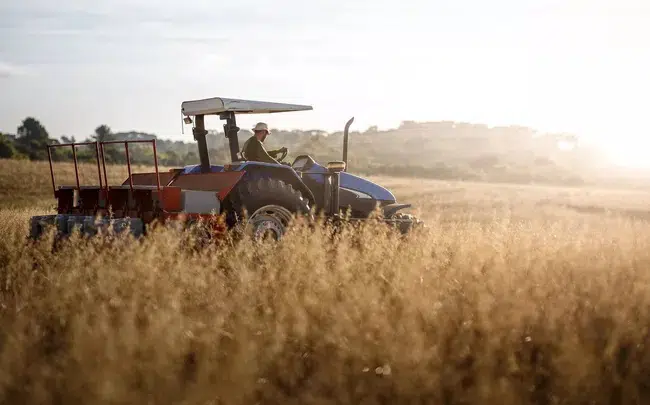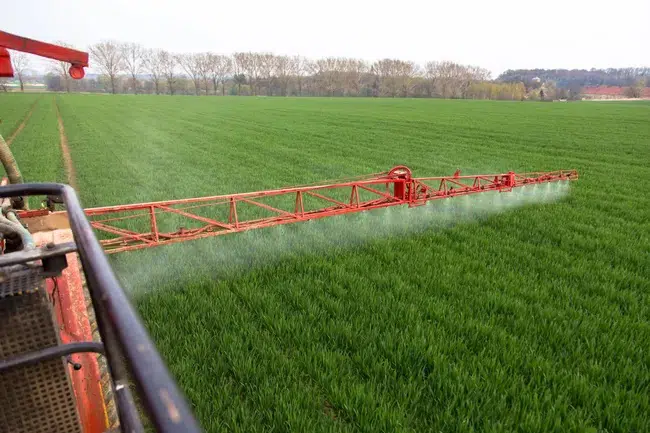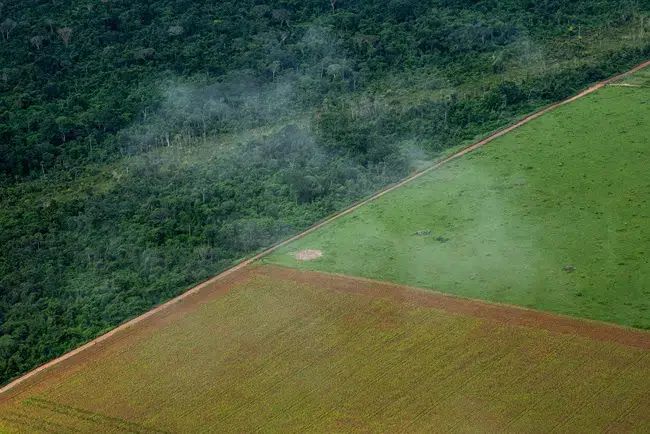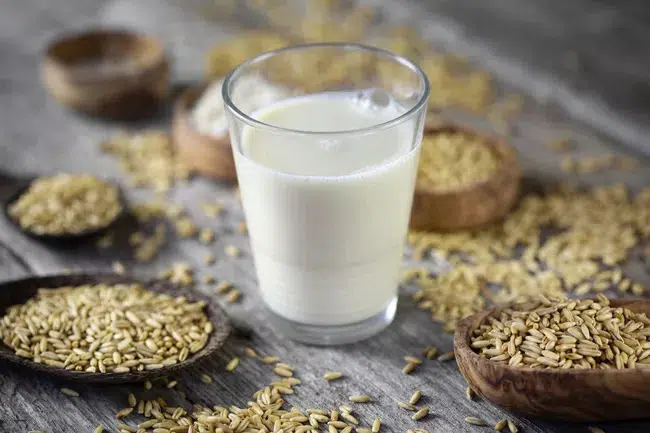by Olivia Young: Soy milk might be the original dairy milk alternative, but oat milk is most definitely the trendiest…
Both are far better for the environment than cow’s milk, mostly because of the methane emissions that come from animal agriculture. But which is greener?
Each crop emits a similar amount of greenhouse gases and uses about the same amount of land and water—so the answer boils down to where it grows and how it’s made into milk.
Learn more about the sustainability of oat milk versus soy milk, including everything from pesticides to food miles to deforestation concerns.
Environmental Impact of Oat Milk
In 2020, oat milk surpassed soy milk as the second most popular alt milk type in the U.S., behind almond milk.1 It now appears on just about every coffeeshop menu and is widely thought to be the most eco-friendly milk type out there. Sadly, it’s also the most expensive.
Water Use
Oat crops generally require the least amount of water out of any plant crop used for milk. The Food and Agriculture Organization of the United Nations puts oats’ crop water needs at 450 to 650 millimeters per growing period. That’s a third of the crop water requirement of bananas, half the requirement of citrus and cotton, and ever so slightly less than the requirement of soy, tomatoes, and potatoes.2
Part of why oats have such a high water use efficiency is because they grow in the cooler season, from about March to July. The lack of heat during this growing period allows the plants to retain their moisture. Plus, they have an admirable “green water” to “blue water” ratio (i.e., water that comes from the sky versus water that’s taken from the ground) of eight to one.3
Oat milk’s water use has been estimated at about 48 gallons per gallon of milk.4
Land Use
The U.S. has just under two million planted acres of oats, with each acre yielding about 65 bushels.5 Texas, North Dakota, South Dakota, and Wisconsin are the top oat-growing states, but the crop grows as far north as Alaska and as far south as Florida. Also from California to Maine.6
This distribution is a testament to the plant’s hardiness. Oats can grow in a wide range of climates and soil conditions, which makes it easy for people to source locally grown oats with fewer “food miles“—the miles food travels from producer to consumer, that is.
Another good thing about oats is that they actually benefit the soil, especially when treated as a “break crop” in between growing other things. They help suppress weeds, suck up excess nutrients, and hold the soil together in cool weather.7 Growing oats between other crop cycles can lead to healthier, more productive crops down the line.
Greenhouse Gas Emissions
Oat milk also has a distinctly low carbon footprint—lower, in fact, than all its competitors, including cow’s milk, almond milk, and soy milk. One glass is equal to 0.4 pounds of carbon dioxide, not including emissions from distribution.4
That carbon footprint comes from the use of inorganic nitrogen and phosphate fertilizers, animal manure, lime application, and diesel for farm machinery, not to mention the nitrous oxide emitted by oat residue.
Speaking of residue: One must also consider the byproduct of oat milk, which is the pulp that gets discarded after the oats are soaked, blended, and strained. All alt milk types have a byproduct. If send to a landfill, this food waste generates a greenhouse gas 80 times more potent than carbon dioxide, which is methane.8 Thankfully, it’s often diverted to animal farms to be used as livestock feed instead.
Pesticides and Fertilizers
Oats can be grown organically—look for the U.S. Department of Agriculture seal—but those not grown organically are often treated with a cocktail of toxic chemicals that penetrate the soil. Eventually, they travel to groundwater reservoirs that run into freshwater systems and out to the sea.
In the U.S., 64% of oat crops in the top 13 oat-producing states are treated with pesticides and even more with chemical fertilizers.9 In 2018, the Environmental Working Group announced that it found traces of weed killer “in every sample of popular oat-based cereal and other oat-based food marketed to children.” The World Health Organization had identified the ubiquitous chemical, glyphosate, as “probably carcinogenic,” it said.10
Thankfully, studies show that glyphosate does not bioaccumulate in humans or other animals and is therefore deemed relatively nontoxic to aquatic life.11 Of course, that’s not the case for all agricultural chemicals. A 2021 report revealed that pesticides “posed a chronic threat to riverine aquatic life” in all five identified regions of the U.S.12
Environmental Impact of Soy Milk
Soy milk is now the third most popular alt milk type in the U.S., behind almond and oat. It is known for being the first widely available vegan milk on the market but has recently lost much of its consumer base due to sustainability and health concerns.
Soy crops have been blamed for widespread deforestation in the Amazon rainforest. Worse yet, crops grown in the U.S. are most often genetically modified to be herbicide-tolerant.13
Water Use
Soybean crops have just about the same water needs as oat crops, about 450 to 700 millimeters per growing period.2 What’s even better than oats is that soy grown for milk production uses a global average of 95% green water and only 3% blue water. So, groundwater reservoirs are not usually being drained for the sake of a soy-based beverage.
However, an extensive 2011 report on the water footprint of soy products revealed that each gallon of soy milk takes an astounding 297 gallons to make, more than six times more than what’s needed to make oat milk. Almost every bit of that—99.7%—comes from the supply chain (including the sugars, maize, and flavorings that go into it), the report said.3
Land Use
Soy crops use a similar amount of land as oat crops and are as hardy as oats, able to adapt to a variety of climates and conditions. Unlike oats, though, which have a global distribution, 80% of the world’s soy is grown in the U.S., Brazil, and Argentina. Soy plantations have replaced vast swaths of the Amazon rainforest, although much of it is used for livestock feed rather than for vegan milk. The World Wildlife Fund says the soybean industry “is causing widespread deforestation and displacement of small farmers and indigenous peoples around the globe.”14
To make matters worse, soy crops are often grown continuously in monoculture even though they can be grown in rotation with other crops. Monoculture soybeans are more heavily reliant on pesticides and fertilizers; without these chemicals, pests and diseases can feed on them for indefinite amounts of time.
The USDA says 90% of soy grown in the U.S. is genetically modified to have herbicide-tolerant and insect-resistant traits.15
Greenhouse Gas Emissions
Columbia University equates a glass of soy milk to 0.4 pounds of CO2 emissions, the same as oat milk.4 But soy’s carbon footprint is inflated by the fact that carbon-absorbing trees are cut to make space for it.
In Brazil, for example, emissions from soy production and export are 200 times higher in some municipalities than others nearby. The fluctuation comes mostly from “the conversion of natural vegetation into arable land,” a 2020 study said.16
In the U.S., emissions from soy production have been declining since 1980. In 2015, the average was 7.5 pounds of CO2-equivalent emitted per bushel.17
Pesticides and Fertilizers
Organic soy represents less than 0.1% of total world production (including that produced for livestock feed, not just human-grade food).18 That means the remaining 99.9% is subject to pesticide and fertilizer use.
USDA data says 44% of domestic acres are treated with just the four most common fertilizers, 98% with herbicides, 22% with fungicides, and 20% with insecticides.19
An investigation by Greenpeace and the Swiss NGO Public Eye found that two thirds of pesticide sales in Brazil were purchased for the country’s soy plantations.20
Which Is Eco-Friendlier, Oat Milk or Soy Milk?
Oat milk is widely considered to be greener than soy milk and, in fact, the greenest nondairy milk available.
While soybean crops have about the same water and land needs as oat crops, soybeans are too often grown in vulnerable regions where vital wildlife habitat must be cleared for them. Plus, they require much more water along the supply chain and must be distributed from three top-producing countries whereas oats grow almost everywhere, all around the world.
Organic oat milk made from locally (or at least domestically) grown oats is more sustainable than soy options. An even better option would be sourcing raw oats from your local zero-waste supplier and making your own oat milk at home.
Whichever milk you choose, it’s important to support ethical, sustainable businesses that are transparent about their supply chains and package their products in recycled and/or recyclable milk cartons. Many come in Tetra Paks—make sure you know how to dispose of them. Often, you must send these cartons back to Tetra Pak as most facilities lack the machinery needed to recycle them.
















































